jtakacs
Well-Known Member
turkey baster.



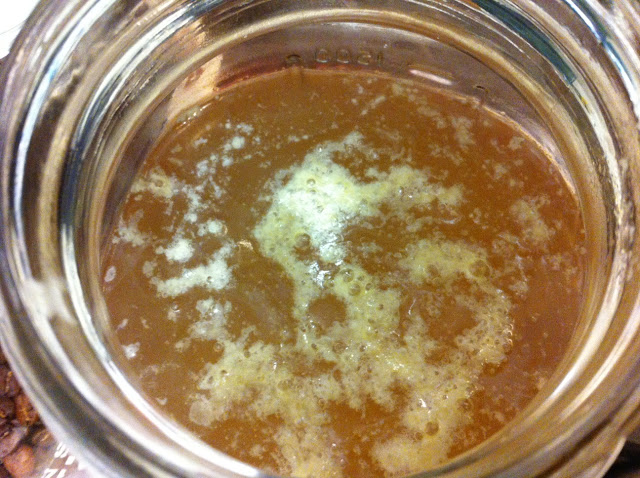
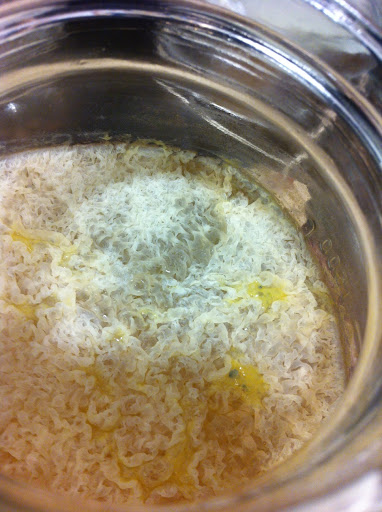
Looks like mold, at least some of it. I have seen yeasts forming this structural pellicle though. Indeed, let it ride for a little bit. Maybe when it starts to go out of control you can do something about it.Such a great thread... I started this about 6 days ago... here's a pic at day 3

Then I went out of town and came back at day 6

What on God's green earth is that? haha... it smells exactly like a nice cows milk cheese. Even my 8 yr old son, when asked to close his eyes and smell, said , "it smells like stinky moldy cheese."
Anyone? Further, what do I do with it? Either way, fun experiment. I'm gonna let it ride.
Meatwad
Such a great thread... I started this about 6 days ago... here's a pic at day 3

Then I went out of town and came back at day 6

What on God's green earth is that? haha... it smells exactly like a nice cows milk cheese. Even my 8 yr old son, when asked to close his eyes and smell, said , "it smells like stinky moldy cheese."
Anyone? Further, what do I do with it? Either way, fun experiment. I'm gonna let it ride.
Meatwad

Meatwad
W T F
Looks a bit too...organized...for comfort. Send off to a lab for analysis, I think you just captured an alien microorganism.
Looks like a combination of the inside of an orange and an animal's intestines.
One of the jars in the 193yr old cellar has a nice fruity and apple smell to it....Still trying to get out to an old country farmhouse in our family to capture some as well.
You seem to be thinking that old buildings will house interesting yeast. I suppose I can't offer solid evidence to the contrary, but keep in mind that yeast dies fairly quickly unless they are reproducing. The living yeast in your cellar has likely just been carried in on a dust particle from outside. The most likely places to find wild yeast are areas visited by insects near hardwood trees in the spring and near fruiting plants in the fall.
There have been numerous extremely old yeasts that have been stepped up - shipwreck bottles, 45 million year old amber, etc.

ODaniel said:I don't believe I had a question.. and yes, I know - all of that. I am more than familiar with wild beers. That is the point of this experiment.
I am stepping them up into quart jars now, then I am going to brew a batch and split into 1gal jugs after they ferment and settle. Those will sit for awhile then I will bottle to see how they progress. Hoping to start the experiment over again soon to see what else I can get.
From left to right: Jar near raspberry bushes (the other jar near them was bad), Jar on a porch under a big tree (crystal clear, had a strong fermentation), 2 cellar jars (hazy but you can see through them).
Yea all I care about is capturing some from the air that makes damn good beer.
I do find it odd that the 2 jars from the basement turned out to be the best smelling ones that fermented, and were less prone to mold.
This is consistent with contamination by a domesticated strain from your brewery. Did you do unopened controls to make sure you're not just growing WLP001?
SandorClegane said:This sounds awesome. But I am so new to this that I have questions.
A) Is there a way to make without using prepackaged dry malt extract? (if I'm going to go all medieval and "do it myself" I might as well do the whole thing from scratch scratch, right?)
B) would this type of yeast be good for Mead?
And do a positive control too, with yeast you use a lot. Unopened controls only give info about if the contamination is already in the jar. Still a good control though, dont get me wrong.
drummstikk said:Great idea -- I second the positive control! The chance of a wild yeast tasting like Chico or whatever yeast you brew with most commonly is pretty small. If you get a similar taste, you can just throw it out.
As for the yeast in honey, I was told a while back that they are osmotolerant yeast like Schizosaccharomyces, and don't do so well in a diluted honey must. I don't know how factual this is, but it makes sense -- sucrose is one thing you can use in the lab to give cells osmotic stress. Cells adapted to live in honey may even burst once the honey is diluted.
But there may be some Saccharomyces spores in there. I bet if you boil water in a flask, let it cool, then pour some honey in there and shake it up, you'll get something to grow.

Well, where did you leave them?A day later and there is something that looks suspiciously like yeast sediment in a couple jars. Is that possible? Or is this probably brewing yeast from my apartment?
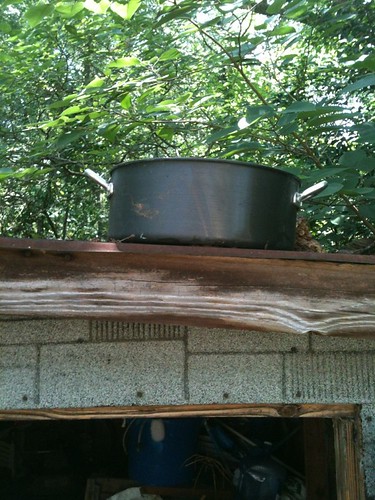
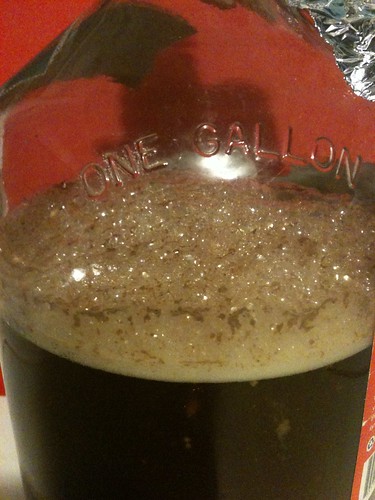
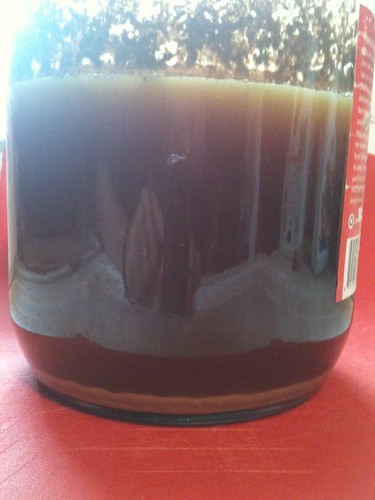
I set out about a gallon of second runnings for around 18 hours before pouring them into a sanitized jug and covering:

Cool ship by danasieg, on Flickr
On around day five there was a thick krausen, and the wort was very active - so I was encouraged indeed:

5 days by danasieg, on Flickr
Now, on day eight, I have a nice layer of what I am sure is yeast on the bottom of the jug:

Day 8 by danasieg, on Flickr
The thing is that it stinks. I am pretty sure I do not have e.coli since it does not smell overly fecal (I can hold my nose over the jug and smell deeply without gagging, etc.). It smells kinda hot and a little rotten (not much unlike sour beers while they are working). I am pretty sure there is lacto and other bugs in there.
I am considering washing the trub, etc. out and then repitching the yeast into another starter. I am not expecting a "clean" beer if I am able to use this, but think removing the yeast from this wort may be helpful at this point.
I am also wondering if leaving it in there will help the yeast take over from what ever else is living in there. My understanding is that this takes 2 weeks. The yeast does not seem that active any more now.
Thoughts?
Ideas?
It seems like a success, if it is indeed all wild.. Did you do any gravity measurements before/after? Where does the two weeks come from? Why would it be helpful to move the beer off the yeast now?
Enter your email address to join: